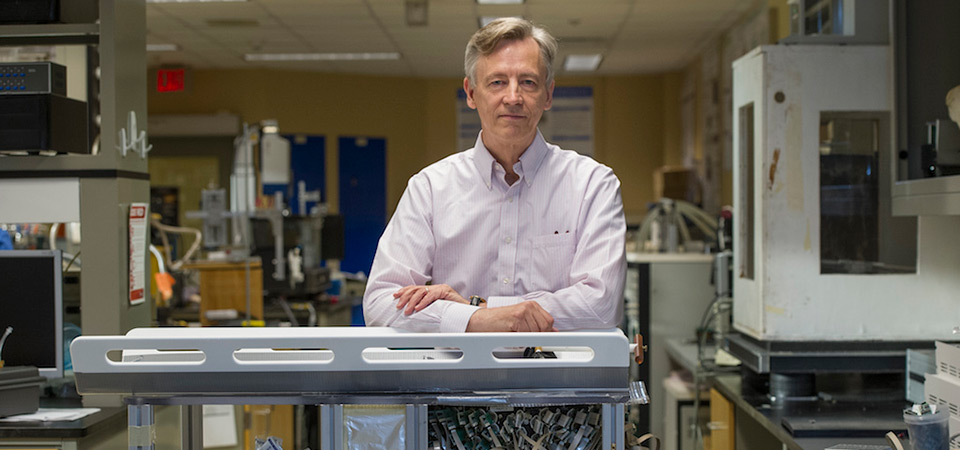Expanding focused ultrasound's therapeutic reach
Dr. Kullervo Hynynen, director of Physical Sciences at Sunnybrook Research Institute (SRI), was awarded $4 million from the Ontario Ministry of Research, Innovation and Science through its Ontario Research Fund Research Excellence program. Hynynen’s award is matched by the private sector and SRI, for a total project value of $12 million.
The aim is to develop new technologies to expand and commercialize clinical applications of focused ultrasound (FUS). Under Hynynen’s leadership, researchers at SRI have made significant headway in using FUS in diverse areas, including neurology, oncology, urology, orthopedics and gynecology.
In 2015, Sunnybrook researchers were the first in the world to use FUS to open the blood-brain barrier noninvasively to deliver chemotherapy into the brain of a woman with brain cancer. In 2016, Sunnybrook was the only Canadian centre in an international clinical trial evaluating the use of FUS to treat essential tremor. Results from that study led the U.S. Food and Drug Administration and Health Canada to approve FUS as a treatment option for essential tremor. Researchers at Sunnybrook made history again in 2017 conducting the world's first clinical trial using FUS to breach the blood-brain barrier in people with Alzheimer’s disease. In recognition of its innovative and comprehensive work in FUS, Sunnybrook was designated a Centre of Excellence by the Focused Ultrasound Foundation in November 2016, the first site in Canada to be so named, and one of only seven in the world.
Hynynen is now exploring the potential of FUS in other areas, including cardiology, specifically to treat irregular heart rhythms using preclinical models. “We are coagulating heart tissue to stop arrhythmias, so ablating arrhythmic areas where the electrical signals are not conducting properly. That is done routinely now with catheters that go into the heart. What we want to do is use external [ultrasound] beams that go directly into the chest wall so you don’t need invasive probes,” he says.
Other projects include using FUS to destroy the nerve along the facet joint to alleviate back pain, and to treat cancer that has spread to the liver. For the latter, Hynynen’s team will build devices that address issues that make removing liver tumours difficult, such as tissue motion and the presence of ribs.
Partnerships are central to bringing new technologies to market. To this end SRI is collaborating with Thunder Bay Regional Health Research Institute (TBRHRI), as well as seven industry partners, including Philips and Elekta. Researchers at TBRHRI are working with Philips to improve the efficiency of MRI-guided FUS surgery to shorten the time patients spend in the MR scanner.
Technology development is a priority for Hynynen, who is devising new methods of guiding and controlling FUS exposures. He is building technology that uses electronically steered phased arrays. Current FUS transducers are mechanically steered, which limits the speed at which therapy is delivered. In addition to being faster, electronically steered transducers provide better control and will eventually be cheaper to manufacture. “With these devices you can follow the movement of organs. For example, you can follow the beating heart and have the focus stay in the same place regardless of how the heart moves,” notes Hynynen. Much of the technology development is taking place within SRI’s Centre for Research in Image-Guided Therapeutics, which has advanced device development facilities and equipment.
He is also incorporating ultrasound imaging into the therapy beam during ablative procedures using a method called local harmonic motion. When tissue is hit with ultrasound energy, there is motion within it that is detectable by ultrasound imaging. “When the tissue temperature is high enough and the tissue coagulates, it becomes stiffer and the motion [decreases]. In animal models we can use that to see when we have reached the target temperature,” says Hynynen.
Using MRI to guide and monitor FUS treatment is effective, but it is also prohibitively expensive in certain parts of the world. Hynynen wants to remove financial barriers to the technology by using ultrasound for image guidance. “Right now we can do it in MRI scanners, which is fine in Canada and U.S., but in third-world countries it’s not so good. In order to take this technology globally, you have to develop cheaper imaging technology.”
Collaborating with Hynynen on the grant are the following researchers.
Sunnybrook Research Institute: Dr. Sandra Black, Dr. Greg Czarnota, Dr. Elizabeth David, Dr. David Goertz, Dr. Laurent Milot, Dr. Meaghan O’Reilly and Dr. Sheldon Singh.
Thunder Bay Regional Health Research Institute: Dr. Margaret Anthes, Dr. Laura Curiel, Dr. Naana Jumah, Dr. Christopher Phenix and Dr. Samuel Pichardo.



